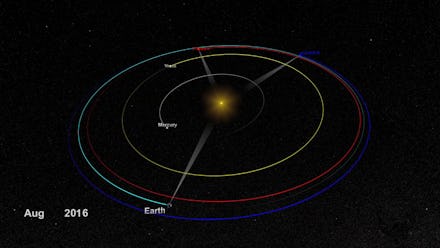NASA just contacted a spacecraft it’s been trying to reach for over a year

On Aug. 21 NASA finally got back in touch with a spacecraft that had been tumbling aimlessly through space for 22 months. The spacecraft was part of a mission helping scientists learn more about potentially dangerous solar flares and coronal mass ejections from the sun.
On October 1, 2014, NASA lost contact with one of the twin space probes that make up the Solar and Terrestrial Relations Observatory. The two STEREO spacecraft launched in 2006 and were designed to orbit the sun with one in front of Earth and one behind.
The set up finally gave us a way to see the whole sun at once. It was also teaching us about the powerful coronal mass ejections, or eruptions of solar matter, which the sun regularly unleashes. A CME, when coupled with a solar flare, which is a stream of high-energy particles from the sun, has the potential to cause trillions of dollars in damage to the Earth.
How it got lost: STEREO was only meant to last until 2008, but NASA extended its mission. The problem is that during the extended mission, the spacecraft's orbital pattern spread out and eventually both STEREO-A and STEREO-B ended up on the far side of the sun, according to NASA.
You can see their positions illustrated in the graphic below. The spacecraft are labeled in blue and red:
"The sun emits strongly in nearly every wavelength, making it the biggest source of noise in the sky," Dan Ossing, mission operations manager for STEREO, explained in a 2015 report from NASA.
NASA planned to pilot the spacecraft through the almost four-month stretch where STEREO would out of range behind the sun. But when mission engineers tested the reset function on STEREO-B to get it ready, they lost contact.
The engineers think the spacecraft woke up from its reset with the wrong information about its position, which made it begin spinning. The spacecraft wasn't able to fully charge up its solar batteries as it tumbled around space.
How it was found: Engineers have finally managed to get back in contact with the probe using the Deep Space Network that keeps track of all of NASA's missions. Now they'll be working on a way to give the spacecraft a checkup and get it back on track.
The STEREO mission is critical to understanding CMEs that come from the sun. A powerful one could potentially slam into Earth and fry our energy grid. It's important that scientists learn more about them, how to better predict them and maybe eventually learn how to shield the planet from them.